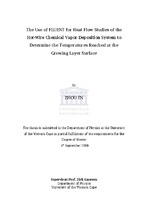| dc.contributor.advisor | Knoesen, Dirk | |
| dc.contributor.author | Zhou, En | |
| dc.contributor.other | Dept. of Physics | |
| dc.contributor.other | Faculty of Science | |
| dc.date.accessioned | 2013-07-23T10:22:09Z | |
| dc.date.available | 2012/10/24 15:34 | |
| dc.date.available | 2012/10/25 | |
| dc.date.available | 2013-07-23T10:22:09Z | |
| dc.date.issued | 2009 | |
| dc.identifier.uri | http://hdl.handle.net/11394/1705 | |
| dc.description | Magister Scientiae - MSc | en_US |
| dc.description.abstract | The overall aim of this project is to study the heat transfer inside the reaction chamber of the Hot-Wire Chemical Vapor Deposition (HWCVD) system with a commercial software package FLUENT6.3; it is one of the most popular Computational Fluid Dynamics solvers for complex flows ranging from incompressible to mildly compressible to even highly compressible flows. The wealth of physical models in FLUENT allows us to accurately predict laminar and turbulent flows, various modes of heat transfer, chemical reactions, multiphase flows and other phenomena with complete mesh flexibility and solution-based mesh adaptation. In this study the 3-D HWCVD geometry was measured and created in GAMBIT which then generates a mesh model of the reaction chamber for the calculation in FLUENT. The gas flow in this study was characterized as the steady and incompressible fluid flow due to the small Mach number and assumptions made to simplify the complexity of the physical geometry. This thesis illustrates the setups and solutions of the 3-D geometry and the chemically reacting laminar and turbulent gas flow, wall surface reaction and heat transfer in the HWCVD deposition chamber. | en_US |
| dc.language.iso | en | en_US |
| dc.publisher | University of the Western Cape | en_US |
| dc.subject | Hot-Wire Chemical Vapor Deposition | en_US |
| dc.subject | Computational Fluid Dynamics | en_US |
| dc.subject | Heat Flow Simulation | en_US |
| dc.subject | Heat Transfer | en_US |
| dc.subject | Radiation FLUENT | en_US |
| dc.subject | GAMBIT | en_US |
| dc.subject | Substrate Temperature | en_US |
| dc.title | The use of FLUENT for heat flow studies of the hot-wire chemical vapor deposition system to determine the temperatures reached at the growing layer surface | en_US |
| dc.type | Thesis | en_US |
| dc.rights.holder | University of the Western Cape | en_US |
| dc.description.country | South Africa | |

